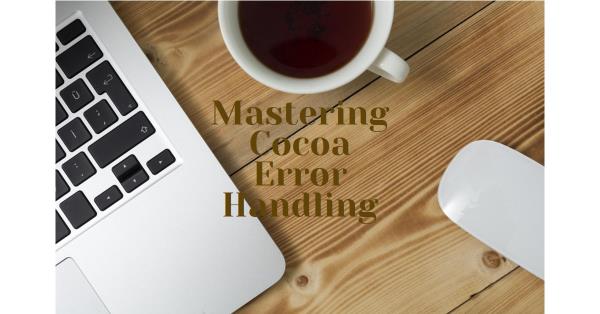Handling errors is critical in software development. It allows apps to handle unexpected events with stability. This post will describe domain mistakes in the NS Cocoa Error. They help developers handle errors well. This guide covers the methods and best practices for handling errors. It focuses on error and Cocoa Touch. It focuses on the NSError class, error domains, and recovery strategies.

Understanding NSError
What is NSError?
NSError is a key class in the Foundation framework. It contains information about errors. It contains information like the error domain and code. Also included is a user information dictionary. The dictionary can contain descriptions and other data. This class is pivotal for representing and managing errors in Cocoa Touch.
Attributes of NSError
An NSError object has several key attributes:
- Domain: A string that identifies the error’s originating subsystem.
- Code: A numeric identifier for the error.
- User Info Dictionary: Contains additional information about the error, such as localized descriptions and underlying errors.
Creating and Using NSError Objects
To create an NSError object, you need to define your error domain and error codes. This allows you to generate specific errors relevant to your application’s context. When an error occurs, you can instantiate an NSError object and pass it back by reference to the calling method.
Cocoa Error Handling Mechanisms
Error Responders and Recovery
Cocoa and Cocoa Touch provide a structured approach to error handling through error responders. These are objects that can intercept and handle errors as they propagate through the application. Before the user sees the error, every respondent in the chain has the opportunity to change it.
Handling Received Cocoa Errors
It is imperative to respond suitably when an error is found. This entails examining the error to determine whether it can be fixed and, if it cannot, informing the user via the relevant message. The goal is to provide a seamless user experience, even in the face of errors.
Recovering from Cocoa Errors
Errors may occasionally be corrected, which might involve retrying an operation, providing alternative options to the user, or correcting invalid input. Implementing robust recovery mechanisms is crucial for maintaining application stability and user satisfaction.

Best Practices for Error Handling
Use NSError for Error Representation
In programming errors, which ought to be handled by exceptions, the recommended method for handling errors in Objective-C is to use NSError. This approach allows for detailed error information and better integration with cocoa errors.
Define Clear Error Domains and Codes
Creating clear and specific error domains and codes helps in identifying and managing errors effectively. This practice ensures that errors are easily traceable and understandable.
Provide Localized Error Descriptions
Including localized descriptions in the user info dictionary of NSError objects ensures that error messages are user-friendly and accessible to a global audience.
Implement Error-Related Delegate Methods
When working with framework classes that perform tasks like network requests, it is common to implement delegate methods that handle errors. This ensures that your application can respond appropriately to issues such as network failures or data parsing errors.
Use Assertions and Logging
Assertions and logging are valuable tools for identifying and diagnosing errors during development. They help in catching programmer errors early and provide insights into the application’s behavior.
Error Handling in Cocoa Touch
UIKit and Foundation Frameworks
Cocoa Touch, the framework for iOS development, includes UIKit and Foundation. UIKit handles user interface elements and event management, while Foundation provides core functionalities like data management and networking. Both frameworks offer extensive support for error handling.
Error Handling in Network Operations
Network operations are prone to errors such as connectivity issues or server failures. Cocoa Touch provides mechanisms to handle these errors gracefully, ensuring that the application can recover or inform the user appropriately.
Testing and Debugging
Thorough testing and debugging are essential for robust error handling. This involves simulating various error conditions and ensuring that the application responds correctly. Tools like XCTest can be used to automate and streamline this process.
Conclusion
Effective error management is vital for creating reliable and user-pleasant programs. By leveraging the NSError elegance, defining clear blunders domains, and enforcing strong recuperation mechanisms, builders can make certain that their Cocoa and Cocoa Touch packages handle errors gracefully. Following exceptional practices and punctiliously checking out mistake scenarios will result in a greater stronger and more pleasurable user enjoyment.
In summary, knowledge and imposing the right handling techniques in Cocoa and Cocoa Touch are crucial for developing awesome packages. By following the guidelines and great practices mentioned in this guide, builders can create resilient programs that offer a continuing experience, even in the face of surprising errors.
FAQs
What is the number one elegance used for error handling in Cocoa and Cocoa Touch?
The primary magnificence used for blunders dealing with Cocoa and Cocoa Touch is NSError. It encapsulates blunders facts, along with the error domain, blunders code, and consumer data dictionary.
What are the key attributes of an NSError item?
An NSError item has numerous key attributes: the error domain, blunder code, and a personal data dictionary that carries additional information about the error, together with localized descriptions and underlying errors.
How can developers create their NSError objects?
Developers can create their NSError objects by defining custom mistakes domains and blunders codes. This allows for the generation of unique mistakes relevant to the application’s context.




More Stories
Saif Ali Khan Attacked: The Shocking Incident Explained
Messi’s Hat-Trick Drives Argentina’s 6-0 Win
How Much Does a Divorce Lawyer Cost in Pune?